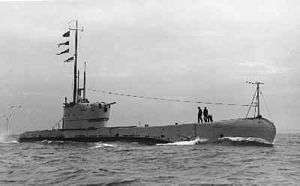HMS Perseus (N36)
HMS Perseus was a British Parthian-class submarine built in 1929 and lost in 1941 during the Second World War. This class were the first to be fitted with Mark VIII torpedoes.
 | |
| History | |
|---|---|
| Name: | HMS Perseus |
| Namesake: | Perseus |
| Builder: | Vickers-Armstrongs, Barrow in Furness |
| Laid down: | 2 July 1928 |
| Launched: | 22 May 1929 |
| Commissioned: | 15 April 1930 |
| Identification: | Pennant number: N36 |
| Fate: | Sunk by mine 6 December 1941 |
| General characteristics | |
| Class and type: | Parthian-class submarine |
| Displacement: |
|
| Length: | 260 ft (79 m) |
| Beam: | 28 ft (8.5 m) |
| Draught: | 13 ft 8 in (4.17 m) |
| Propulsion: |
|
| Speed: |
|
| Range: | 8,500 nmi (15,700 km) at 10 kn (12 mph; 19 km/h) |
| Complement: | 59 |
| Armament: |
|
At the start of the war, she was operating under the command of Commander Peter Bartlett on the China Station as part of the 4th Submarine Flotilla, along with all of the other members of the class. This continued until August 1940 when the class was reassigned to the Mediterranean, where part of the duties were the ferrying of supplies between Alexandria and the besieged island of Malta. She underwent a refit at Malta from October until April 1941.
Attached to the 1st Submarine Flotilla, based in Alexandria and under the command of Lieutenant-Commander Edward Christian Frederick Nicolay DSO RN (see Nicolay (family)), she sank the 3,867-ton Italian tanker Maya 5 nautical miles (9 km) south of Tenedos on 5 September 1941, and the following month, on 2 October, the 2,086-ton merchant ship Castellon west of Benghazi. It was for these actions that Commander Nicolay received the Distinguished Service Order.
The submarine sailed from Malta for Alexandria on 26 November 1941 with instructions to patrol waters to the east of Greece during her passage. She apparently torpedoed a ship on 3 December but at 10 pm on 6 December struck an Italian mine off Cephalonia, 7 miles (11 km) north of Zakynthos in the Ionian Sea.
Of the 61 on board, the only survivor was 31-year-old leading stoker John Capes, one of two non-crew members hitching a lift to Alexandria. He and three others escaped from the submarine using the Twill Trunk escape hatch in the engine room and wearing Davis Submerged Escape Apparatus.[1] However, only he survived the journey to the surface and the five-mile (8 km) swim to the island of Cephalonia, where he was hidden by islanders for 18 months before being smuggled in a caïque to Smyrna in Turkey.[2] He was subsequently awarded a British Empire Medal.
The wreck, at 52 metres (171 ft) below the surface, was discovered and surveyed in 1997 by Kostas Thoctarides and his dive team.
The Perseus lies on the seabed with a starboard list. On her port side, near the bow, there is a crack caused by her collision with a mine. That is the only significant damage to the vessel. The rest of her hull is in good condition. Her gun, her steering wheel, and everything else is in place. Her compasses, which are still working, show her last course. The escape hatch of the stern compartment is open.
Close to Perseus divers found the anchor of an Italian mine; a discovery that seems to confirm that an exploding mine was the cause of her sinking. British authorities had assumed that this was the case, but it had never been confirmed.
On 19 and 20 May 2000, memorial ceremonies were held in Cephalonia in honour of the Perseus' crew. It was attended by relatives of the deceased (including John Capes' daughter), members of the Submarine Old Comrade's Association or Gatwick, locals who hid Capes, a member of the caique crew who transported Capes to Smyrne etc.[3] [4]
| Wikimedia Commons has media related to HMS Perseus (N36). |
External links
- HMS Perseus submarine Video, 24 mins. Diving to the wreck site.
- Υποβρύχιο Περσεύς - Διαφυγή από το Θάνατο (HMS Perseus submarine). Video, 29 mins.
- H.M.Submarine Perseus 2007 in .... Video. Diver inside the wreck.
- The Man Who Survived for 18 Months On an Island After His Submarine Sank. Video, 10 mins.
References
- "Submarine Casualties Booklet". U.S. Naval Submarine School. 1966. Retrieved 8 September 2009. Cite journal requires
|journal=(help) - Clayton, Tim (2 December 2011). "Submarine escape: A WWII survival tale from Kefalonia". BBC. Retrieved 4 December 2011.
- [Rena Giatropoulou & Kostas Thoktarides, "Submarine Perseus. Escape from death", published by Finatec Ltd for the Prefecture of Kefalonia and Ithaca, (date not specified), pp 93-97, in greek language. ISBN 960-8159-07-5]
- "Corelli's island split by Briton's great escape", The Guardian.
- "The great escape". Divernet. Archived from the original on 14 May 2012. Retrieved 2 December 2006.
- Submarine Heritage Centre
- RN Submarine museum
- Greek Navy website with information on Perseus and the diving expedition that located the wreck
- British Submarines of World War II - Pandora to Sealion
- Submarine escape: A WWII survival tale from Kefalonia